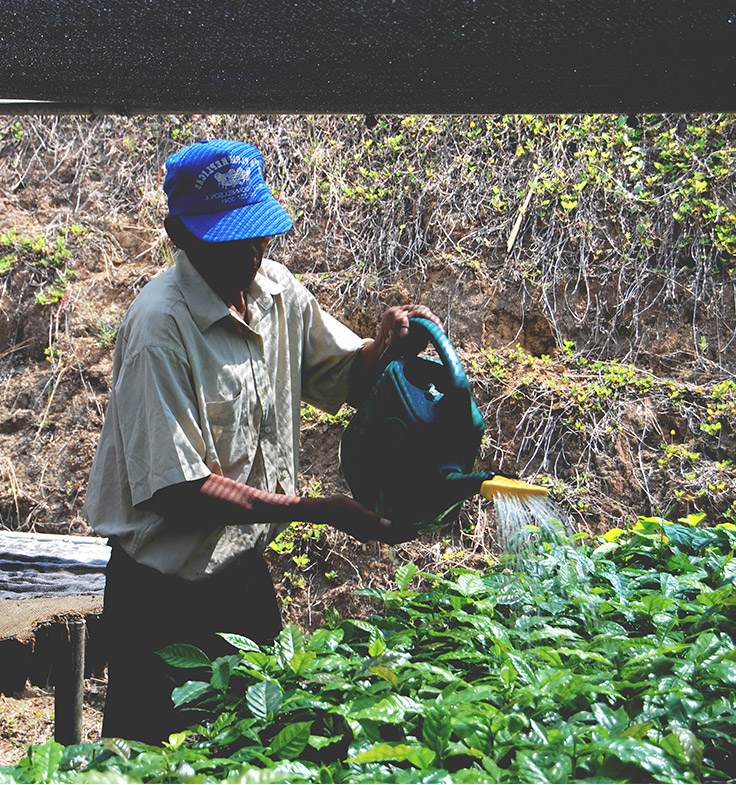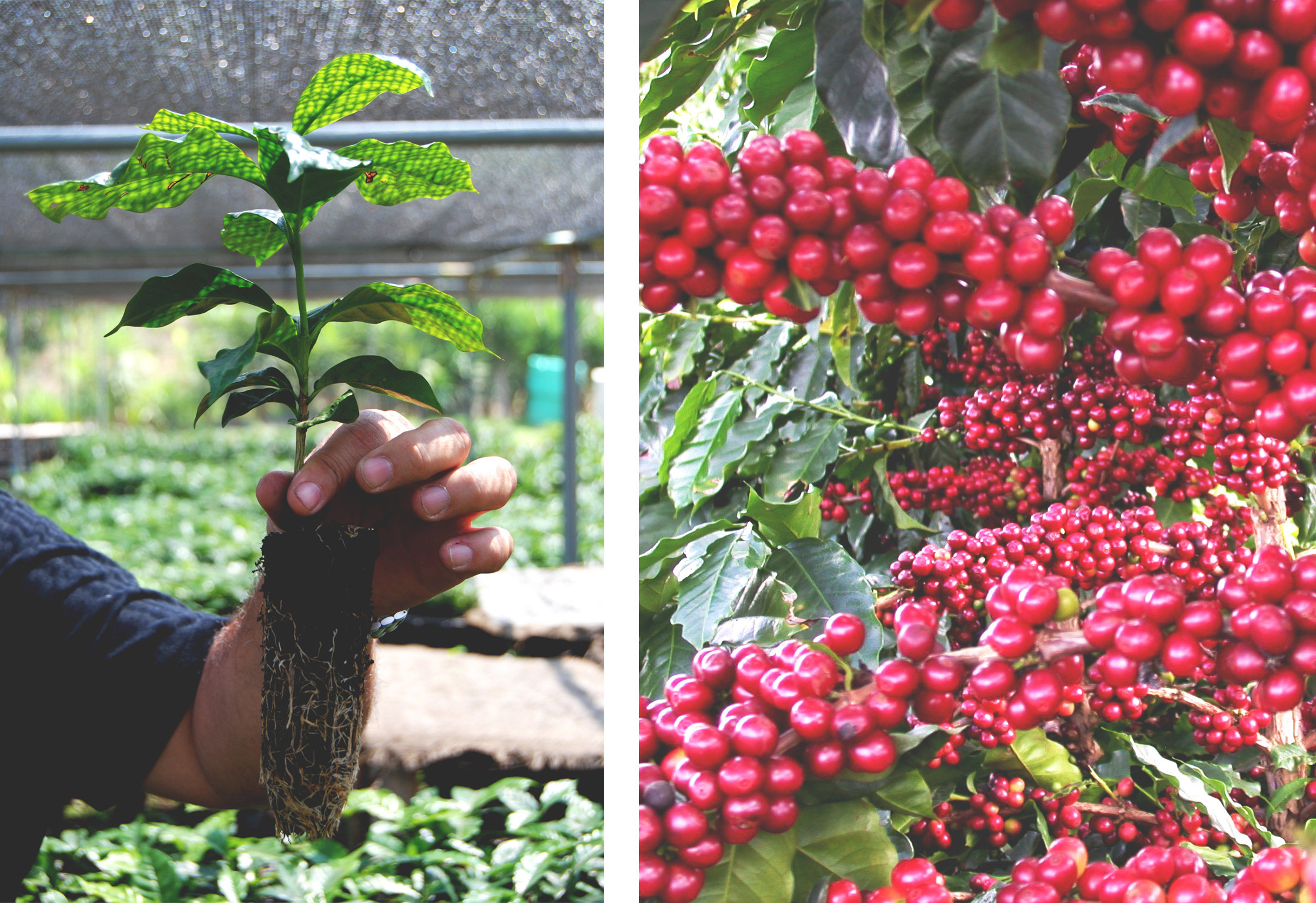tf course, the bean varieties and the roasting of coffee are basic issues when choosing one coffee or another. However, today from Cafés El Magnífico we want to travel back to the beginning and explain everything about the coffee tree or the coffee plant.
It is a seasonal plant whose flowering, growth and harvesting periods are determined by the seasons. Its structure from the root to the branches is robust to offer a fruit or cherry that is the jewel in the crown.
Today we are going to review all the parts of the coffee tree or coffee plant. We will talk about its roots, its branches, its flowers and its fruit. In addition, we will review those environmental conditions that directly influence the cultivation of the coffee plant and the quality of the fruit.
The objective is for you to learn where and how the coffee tree grows that ends up producing the specialty coffee that you have in your cup. Let’s begin.

Root and trunk of the coffee tree
The coffee tree is an evergreen shrub and consists of a main root that can be 50 cm or more in depth. From this root originate the secondary roots that serve as anchors and the tertiary roots from which emerge the rootlets (hair) that serve the plant for the absorption of water and nutrients.
The root development of the coffee plant is very important for its growth, production and longevity. For this reason, from the seedling stage it is important to achieve a well-formed main root in order to obtain excellent growth in the field.
The trunk of the coffee tree or coffee plant has buds from which two types of branches arise: the sons or vertical branches and the horizontal producing branches or “bandolas”. The leaves are born in the terminal part of the stem and in the bandolas and their main function is associated with photosynthesis and photorespiration. Both processes are essential to regulate the productive activity.
Flower and pollination
Flower initiation and growth is influenced by sunlight, water and temperature. In order for the buds, located at the nodes of the bandolas, to become flowers, they must be stimulated by hormones produced by the plant. In order to produce the necessary flowers, short days and long nights are required. The white flowers of the coffee tree give off a strong scent of jasmine and last about three days. Sure,The spectacle of a coffee tree in bloom is a magnificent and unforgettable memory.
The fruit
After pollination the berries develop. It is 6 to 9 months after flowering. The fruit has a slow growth at the beginning. It first develops the locules (parchment) where the seed that will fill later will be lodged. The size of the locules and therefore of the seeds depends on rainfall during the period of their formation.
The fruit grows rapidly when it begins to ripen and demands a large amount of nutrients from the plant to thicken the pulp, which is the food reserve of the seed, and the mucilage (honeys).
gradually
These cherries are made up of:
- that red or yellow shell
- a sweet and gelatinous pulp
- a membrane called parchment, pale yellow in color and of a hard and fragile consistency
- sure a very thin membrane called silver skin, thinner than the previous one and adhered to the grain and two seeds.
The abortion of one of these seeds due to increased exposure to sun or water causes the formation of a single, round bean, known as a snail, which in arabica plants represents approximately 10% of the tree’s production.

ENVIRONMENTAL CONDITIONS OF THE COFFEE PLANTATION
The coffee plantation is composed of the coffee plants, the shade trees, other plants and animals that live in it, and the coffee grower’s family and his collaborators. The soil, springs, rivers and water brought by rainfall are also part of the coffee plantation.
Establishing a coffee plantation consists of planting coffee trees in a potential area or in areas where it has been eliminated or lost. This requires the integration of agro-ecological conditions and technical resources in such a way that several issues are taken into consideration. Thus, climatic, topographical and other factors studied by prestigious agronomists and universities are taken into account.
Several elements influence the physical, organoleptic and biochemical characteristics of coffee. Among these aspects: altitude, soil, shade, varietal, productivity and processing are the most important.
From the agro-ecological conditions it is necessary to pay special attention to the physical conditions of the soil such as depth, texture, structure, topography and stoniness. Also the chemical conditions such as organic matter content – not less than 2%, nutrients and pH – between 5 and 6.
For the coffee grower it is very important that his coffee trees give a good production, so they must be well nourished. An excess of potassium and calcium in the soil produces a hard and bitter beverage (van der Vossen, 2009).
Forest and shade trees
The roots of the forest and shade trees in the coffee plantation penetrate into the deep layers of the soil, aerating them and making them more permeable. The constant fall of leaves and branches (organic matter) feeds earthworms and other small soil inhabitants.
Their activity reconstitutes the soil, making it more porous and granular. They incorporate organic matter, making it deeper and more fertile. Manure and mulch benefit the soil by providing it with decomposing nutrients. In turn, soil crust fluctuations are reduced and soil moisture is increased and preserved. It also enhances the activity of microorganisms, controls soil erosion and helps suppress weeds.
The soil of the coffee tree or coffee plant
Soils that cannot nourish the coffee plants in the quantities they need in a balanced manner require the use of fertilizers. In this way the coffee plants can have a healthy growth and a good productivity. What should be used, in what quantity and the time of application depends on the degree of acidity or alkalinity (pH) of the soil, the productivity and other cultivation practices.
Optimum temperatures for coffee plants
Average annual temperatures between 18°C and 22°C are the most favorable for Arabica coffee, although minimum and maximum temperatures must be taken into consideration.
Minimal because the coffee tree is not very tolerant to low temperatures and should not be planted in areas subject to frost. Low temperatures during the winter period will delay ripening and shorten flower bud development.
Maximum because where temperatures are very high for long periods of time the damage caused to production will be great. The reason for this is that flower buds abort and few fruits are produced.
In addition, the plant will be less efficient in photosynthesis since it will not absorb CO2. Coffee plants that grow under shade and in soil with adequate humidity are able to withstand extreme temperatures for a longer period of time.
Rain and water
For coffee plants, not only the amount of rainfall received is important, but also its distribution during the different months of the year. An adequate amount of rainfall, 1200 to 1800 mm/year, is essential for the vegetative growth of the plant. It is also essential for good flowering and for adequate fruit development.
Rainfall received 20 to 30 days after flowering will be helpful in maximizing the amount of fruit on the branches. When the number of rainy days is very high and rainfall is well distributed the following year’s crop growth will be very good.
However, a long dry period is detrimental to good plant development and forces plants to compete with each other for available water. A dry period before flowering is good because it concentrates the opening of flowers and the subsequent harvest.
The rainy season is very important for coffee farms because it activates the springs and fills the ponds, lakes and reservoirs. Areas with a tendency to have rainfall exceeding 2500 mm have a tendency to produce low quality coffees. The reason for this is irregular ripening and a poor level of drying after the milling process. In years with drought, the tree produces a large amount of empty beans which will result in a liquor with unripe and astringent notes.
Light and the growth of the coffee tree or coffee plant
The quality and quantity of light is also important since coffee plants are very sensitive to light. This has to do with the efficiency of photosynthesis in the leaves.
Too much bright light can saturate and stop photosynthesis processes. Too much shade reduces the quality of light and photosynthesis is also poor. The hours of sunlight that a coffee plant makes best use of are in the morning and the least in the vertical midday.
When the number of plants per hectare is increased and smaller varieties with denser foliage are grown, the crop produces light-regulating self-shading. This larger number of plants covers the soil better with their branches, preventing the soil from heating up in direct sunlight and protecting it from rain splash.
The wind
Light winds of 5 to 15 km/hour favour the microclimate of the coffee plants. However, winds above 15 km/hour cause damage to leaves, branches and stems of the coffee tree or coffee plant. In addition, they also favour the fall of fruits and loss of soil humidity. All in all, these problems are accentuated when strong winds occur at the same time as low temperatures. A frost-like effect is then produced, known in Brazil as ‘geada de vento’. To counteract these negative effects, the coffee grower builds windbreaks. This is an important practice in high and medium altitude coffee plantations. The structure consists of rows of shrub-like plant species, planted in such a way that they intercept the strong and prevailing winds perpendicularly.
The altitude of the coffee plantation
Decazy et al, 2003 demonstrated in a study for quality coffees in Honduras the strong inverse relationship between rainfall and fat content in the bean. Furthermore, they concluded that this relationship has to be taken into account in relation to altitude. Coffees from higher altitudes have a higher fat content than those from lower altitudes and give better cup quality.
Altitude tends to have a positive effect on acidity while reducing bitterness. East-facing mountain slopes have higher drinking qualities probably due to exposure to the morning sun (Avelino et al, 2005).